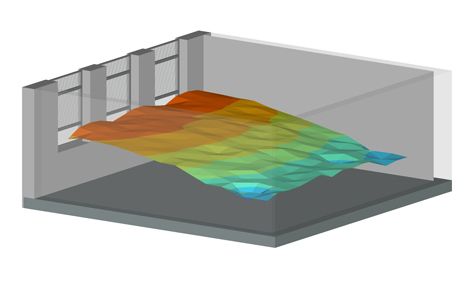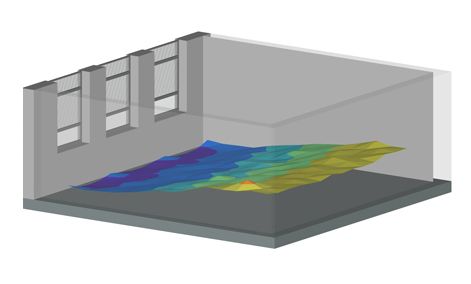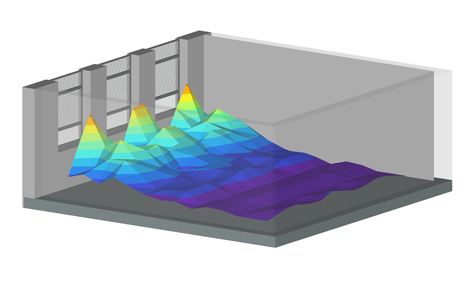CBDM
Climate-Based Daylight Modelling (CBDM) is an advanced method for simulating and analysing daylight within architectural 3D computer models.
Unlike traditional approaches, such as Daylight Factor (DF%) analysis, which only considers static sky conditions, CBDM use real local climate data to assess daylight performance throughout a typical year, under varying sky and weather conditions.
This dynamic, location-specific approach provides a more realistic understanding of how daylight interacts with buildings, enabling better-informed design decisions that improve comfort, energy performance, and compliance with standards such as the DfE daylight requirements for schools or BS EN 17037.
The dynamic nature of daylight makes annual simulation a complex and computationally expensive process. Whilst the position and movement of the sun can be precisely calculated and modelled, it is virtually impossible to precisely predict future sky (weather) conditions.
Whilst every effort is made to ensure the accuracy of CBDM results, in reality, the resulting data will never be wholly accurate – it will only be representative of a typical year. TMY weather files are intended to represent a ‘Typical Meteorological Year', designed to be used for making estimates of predicted energy consumption. TMY files are composite of average months from a database of historical weather data.
In response to the dynamic nature of daylight, CBDM metrics such as Daylight Autonomy or Useful Daylight Illuminance do not focus on predicting absolute instantaneous light levels but instead, analyse the area of the space [where] and period of the year [when] a specific illuminance target or illuminance range can be expected to be achieved.
This provides a more holistic understanding of the varying illuminance levels throughout a typical year, in direct response to the local climate, and therefore does not just focus on 'worst-case' overcast sky conditions.
This approach to daylight analysis helps to ensure shading is considered as part of the design strategy, to help in reducing potential unwanted visual comfort issues, such as glare and veiling luminance, as well as enabling the energy-saving potential of a daylight-linked electric lighting system to be more accurately and realistically assessed.
CBDM Metrics
Daylight Autonomy (DA) is the percentage of time that a target illuminance level is achieved, or exceeded. The measure is typically taken across a year, during hours of operation. Theoretically, DA could be measured daily, weekly, monthly or any other time period. DA is typically measured across the working plane of a space, with DA values being calculated at each grid point.

Spatial Daylight Autonomy (sDA) defines the percentage of time that a target illuminance (typically 300lux) is achieved across a defined percentage of floor area (typically 50%).
In England, the DfE requires and sDA (300/50%) ≥50% across at least 50% of the working plane, during occupied hours.

Useful Daylight Illuminance (UDI) is a measure of daylight availability, during hours of operation. Rather than a specific target illuminance, UDI analyses the percentage of time that a target range of illuminances can be achieved.
Typically, UDI is divided into three ranges; UDI-s (<100lux), UDI-a (100-3000lux), and UDI-e (>3000lux).

UDI-s (<100lux) is a measure of daylight availability, during hours of operation, below the target range of 100-3000lux.
In England, the DfE GDB specifies that the UDI-a (100-3000lux) should be ≥80% (ave), across the working plane of each space, during occupied hours. This means that the UDI-s & UDI-e cannot exceed 20% (combined).

UDI-a (100-3000lux) is a measure of daylight availability, during hours of operation, within the target range of 100 - 3000lux.
In England, the DfE GDB specify that the UDI-a (100-3000lux) should be ≥80% (ave) across the working plane of each space, during occupied hours.

UDI-e (>3000lux) is a measure of daylight availability, during hours of operation, above the target range of 100-3000lux.
In England, the DfE GDB specify that the UDI-a (100-3000lux) should be ≥80% (ave) across the working plane of each space, during occupied hours. This means that the UDI-s + UDI-e cannot exceed 20% (combined).

Services
With over 20 years of experience in Climate-Based Daylight Modelling (CBDM), Lighting Analysts offer specialist services to support daylight design and compliance:
- Climate-Based Daylight Modelling (CBDM)
- Daylight Autonomy (DA) and Spatial Daylight Autonomy (sDA) assessment
- Useful Daylight Illuminance (UDI) analysis
- DfE daylight compliance reports for schools
- BS EN17037 daylight assessments
- Cumulative exposure in museums and galleries
- Design advice to optimise daylight and reduce glare
- Integration of daylight with electric lighting design
Our team provides expert, project-specific analysis to help you deliver daylight-compliant, well-lit spaces.
